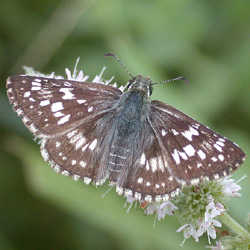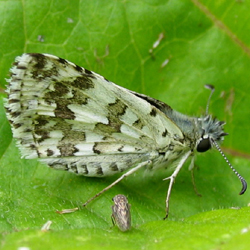Butterfly Atlas
Find a Butterfly
Common Checkered Skipper
Pyrgus communis
Named
Grote, 1872

Identification
Wingspan 3/4 - 1 1/4". Butterflies of the genus Pyrgus are very distinctive, being mainly dark with bold white checkering. Males of the Common Checkered Skipper have gray-blue hairs on body and basal area of wings above. Females often darker, with smaller white checkering. Hindwings below are yellowish white, crossed with bands of olive brown.
Distribution
Continent-wide, from southernmost Canada south through Central and South America to Argentina. Scarce or absent from the Pacific Northwest and the Northeast. Resident south of the 40th parallel, with emigrants flying north into the northern part of the range in summer. Recently regular and fairly frequent in New York state, but still rare in southern New England.
Status in Massachusetts
Rare and sporadic in Massachusetts as an immigrant and temporary breeder. Known in Scudder‘s day from a single northeastern record "near the mouth of the Hudson" (Scudder, 1889). Farquhar (1934) gives records for Brookline, 11 November 1915 and E. Woburn, 22 May 1903. Macy and Shepard (1941) note that "only two or three records are known from the vicinity of Boston, Massachusetts. A population of 25-30 individuals discovered at a community garden in Pittsfield (Berkshire Co.) by Edna Dunbar on 15 July 1991. The species scarcity here is somewhat surprising in light of the frequency of records in New York as close as the lower Hudson Valley; Tudor (pers. comm.) says it has been recorded recently "about as frequently as Variegated Fritillary".

Flight Period in Massachusetts
22 May to 11 November.
Larval Food Plants
Members of the Mallow family (Malvaceae), including Common Mallow (Malva neglecta) and Velvetleaf (Abutilon theophrasti), the favored hosts around New York City (Tudor, pers.comm.).
Adult Food sources
Numerous flowers, including several white-flowered composites, are visited.

Habitat
Open situations generally, including meadows, gardens, waste areas, and roadsides.
Life Cycle
EGG: Greenish when first laid, gradually changing to cream-colored; dome-shaped, with prominent ridges. OVIPOSITION: Eggs laid singly, on the upperside of leaves or buds. LARVA: Yellowish-white to brown with brown and white stripes along each side, a grayish stripe down the back, blackish head and first thoracic segment, and dense, short, whitish hairs over the body. PUPAL STAGE: Unrecorded? CHRYSALIS: Green, with light brown abdomen. OVERWINTERING STAGE: As mature larva in a folded-leaf nest. According to Shapiro (1974) populations in western New York overwinter successfully.
Males patrol a small area, about thirty meters in length (Opler and Krizek, 1984), flying rapidly back and forth within their chosen area.
Account Author
Chris Leahy



